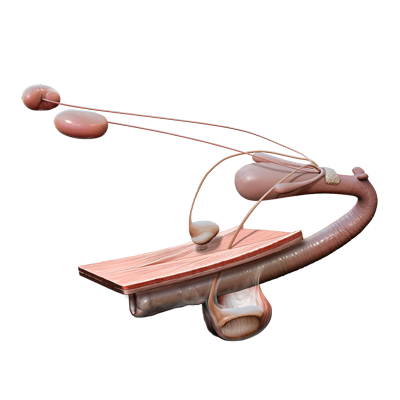
The urogenital system includes the urinary and reproductive organs.
The urinary system is divided into two regions based on anatomy and function: upper (kidneys and ureters) and lower urinary (urinary bladder and urethra) tracts. The kidneys filter metabolic wastes from the blood to be excreted into the urine. The kidneys also participate in blood pressure regulation and maintenance of the delicate electrolyte and water balance within the body-keeping only what is needed. The ureters bridge the upper urinary tract to the lower urinary tract. The lower urinary tract serves as a reservoir for urine (bladder) and a pathway for excretion (urethra). Indications of a urinary tract problem can be varied: excessive urination and drinking, straining to urinate, blood in the urine, odor to urine, diarrhea, inappetance, incontinence, colic, and lethargy.
The genital system consists of the reproductive organs-testicles and the accessory genital glands. These organs produce hormones and allow reproduction. Signs associated with genital tract problems in mares include: abortions, discharge, odor, straining to urinate, colic, and lethargy. Genital tract abnormalities in stallions may manifest as: discharge, odor, straining to urinate, scrotal/penile swellings, and lethargy.
Common urogenital ailments affecting horses:
Stallion:
o Sperm abnormalities
o Trauma to external genitalia
o Venereal disease: bacterial, viral, Contagious Equine Metritis
Foals : Ruptured urinary bladder; Patent urachus; Cryptorchidism
Kidney failure : acute and chronic. Acute kidney failure can be caused by infections, kidney stones, toxins, and drugs to name a few. Aging pets may develop chronic kidney failure. Often, by the time chronic kidney failure is diagnosed, the cause cannot be determined.
Bladder

Urine, produced by the kidneys, is stored in the urinary bladder before exiting the body through the urethra. The urethra acts as a channel for urine excretion; its length offers protection against infection. Urinary tract infections are uncommon in horses, unless they have a condition that causes abnormal urine flow: mares prior to foaling, recumbency, and anatomical defects (e.g.: patent urachus, ectopic ureters). Horses with urinary bladder abnormalities may strain to urinate; they may have obvious blood in their urine or evidence of urine scalding.
Castration

Castration removes the testosterone producing testicles housed within the scrotum. This surgical procedure is performed in stallions: that will not be used for breeding; to avoid unwanted behaviors; that have retained testicles, testicular trauma or tumors. The surgery can be performed with sedation and regional anesthesia or under a general anesthesia. Gelding often recover uneventfully from this procedure.
Cryptorchid

During development of the fetus, the testicles form in the abdomen close to the kidneys. They then descend through the inguinal rings into the scrotum. The failure of one or both testicles to complete this journey results in an intra-abdominal or inguinal cryptorchid. These testicles are usually sterile, but still produce testosterone.
Urogenital Normal

The stallion’s reproductive tract includes two testicles, housed within the scrotum, and the accessory glands (i.e.: prostate, seminal vesicles, ampullae, and bulbourethral). Male horses achieve sexual maturity around 15 months of age. During breeding, stallions may be prone to penile trauma and infections. Stallions may be castrated or gelded (surgical removal of the hormone producing testicles) around 1-2 years of age to avoid unwanted behaviors. Older horses may develop tumors within their reproductive tract.
What's Next
Call us to schedule an appointment
Meet with a doctor for an initial exam.
Put a plan together for your pet.

